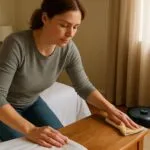Microwave ovens get messy fast, so knowing how to clean a microwave matters. Splatters stick to the walls and the glass turntable, and then the kitchen starts to smell off. Heating soup or pizza can leave dried sauce or cheese that feels like it is glued on.
Many families already own what they need: vinegar, lemon juice, or baking soda. This guide walks through quick steps that make cleanup simple. It also shares natural methods that use safe items already in the pantry.
With a few smart tricks, the job takes minutes, not an afternoon. Try them before the next meal splatter turns into a sticky project.
Key Takeaways
- Clean the microwave weekly to avoid stubborn buildup, a clean kitchen supports healthier homes.
- Use natural cleaners like vinegar, lemon juice, or baking soda with a microwave-safe bowl to remove stains and odors without harsh chemicals.
- Steam cleaning softens hardened spills in under five minutes, always let steam cool before wiping to prevent burns.
- Remove, wash, and fully dry the turntable after big spills or at least weekly to limit bacterial growth.
- Clean the grease filter on schedule because clogs reduce performance, replace worn filters to reduce lingering cooking smells.
Why Regular Microwave Cleaning is Important
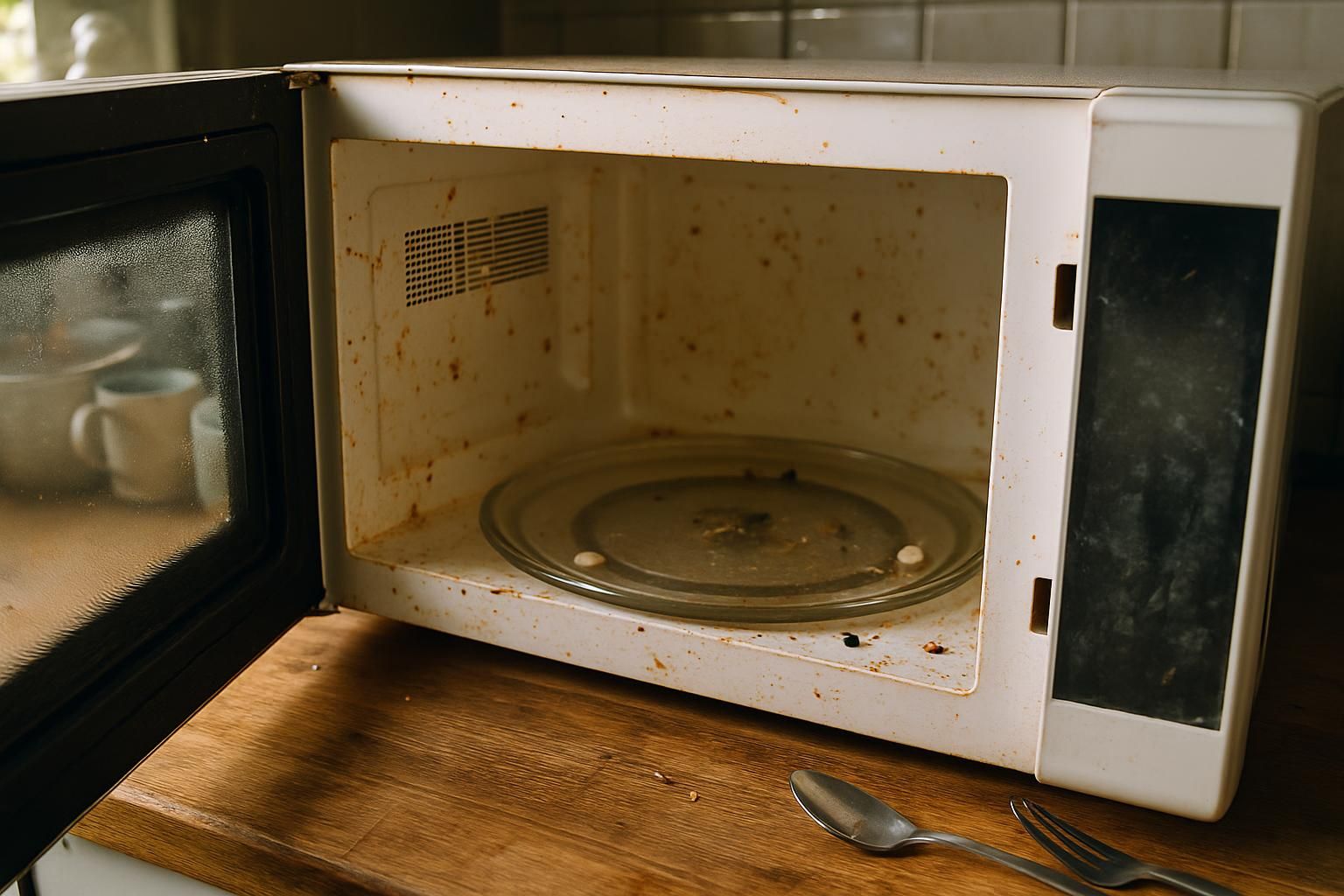
Sticky sauces and crusty food bits hide in corners and under the plate. Spilled soup or pizza splatter dries hard and leaves stains and funky smells. Grease and odor can even affect the taste of future meals if the mess sits.
Food explosions happen when steam builds up under a cover, sending particles across the interior. Whirlpool’s Care Counts Laundry Program highlights how a clean home supports healthy kids, and a clean microwave is part of that picture.
Weekly cleaning prevents heavy buildup and lowers the effort needed later. Wipe after big spills so gunk does not bake onto the walls and ceiling.
Food particles attract germs. A quick wipe of the turntable and door seals helps protect family meals. A simple cloth with water or a vinegar mix keeps hygiene on track, just like tossing sponges into the dishwasher from time to time keeps the kitchen cleaner overall.
What You’ll Need to Clean Your Microwave
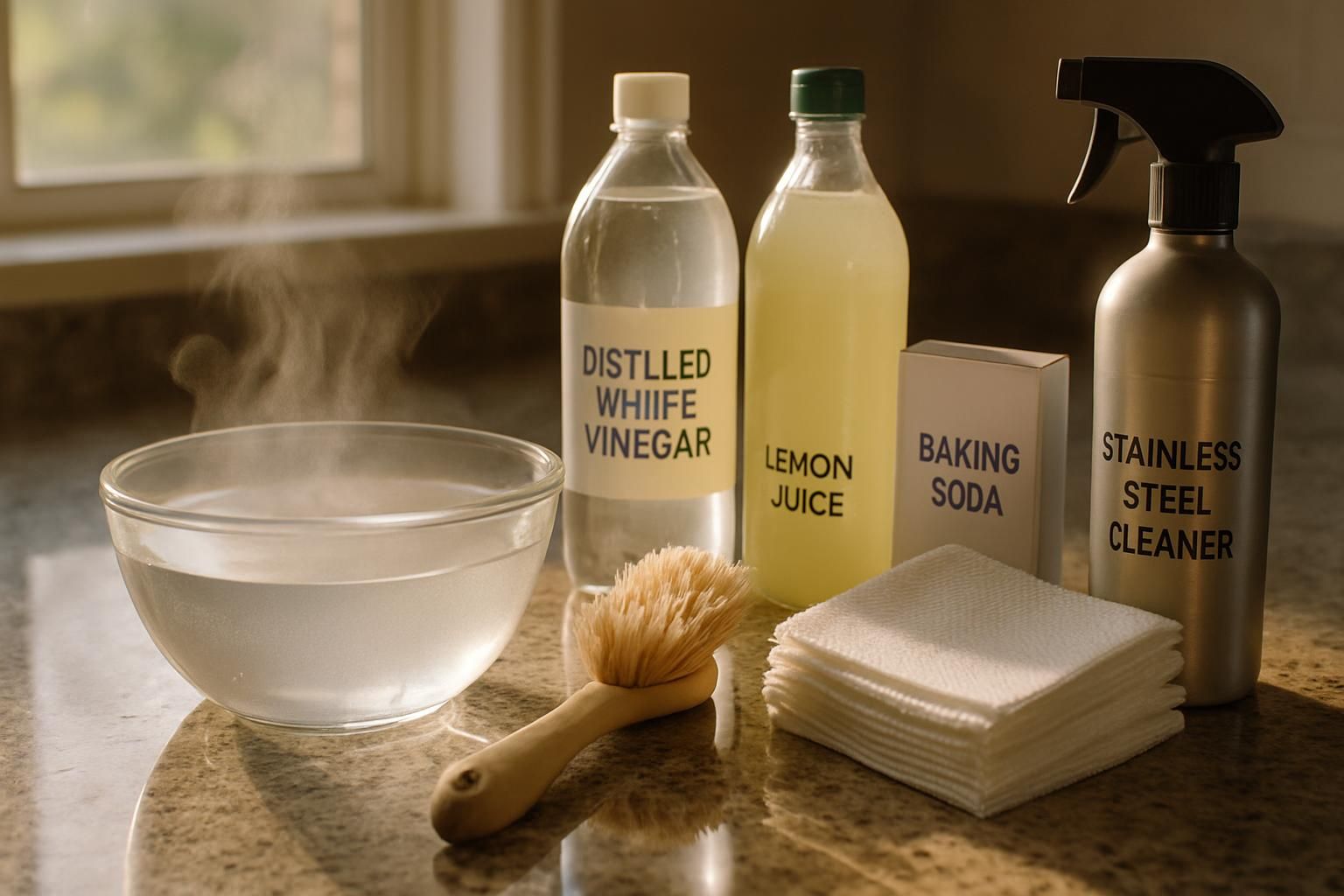
Once the why is clear, gather a few simple tools. There is no need for special gadgets, just basics that work every time.
- A microwave-safe bowl or a microwave-safe container for steam cleaning tough messes.
- Distilled white vinegar or lemon juice to fight odors and sticky spots with natural power.
- Baking soda to tackle stubborn splatters and burnt-on debris.
- Dish soap such as Dawn Platinum to loosen grease on the turntable and interior walls.
- A soft cloth or non-abrasive pad to avoid scratches on glass or plastic.
- Scrub brushes for problem areas that resist normal wiping.
- Paper towel or a washable cloth for routine wiping and final drying.
- Stainless steel cleaner for the exterior, and glass cleaner for shiny buttons and screens.
Preparing Your Microwave for Cleaning

Before starting, unplug the unit if that makes the job easier. Grab a damp sponge, remove the microwave-safe turntable, and check for crumbs or spills under it.
Remove and inspect the turntable
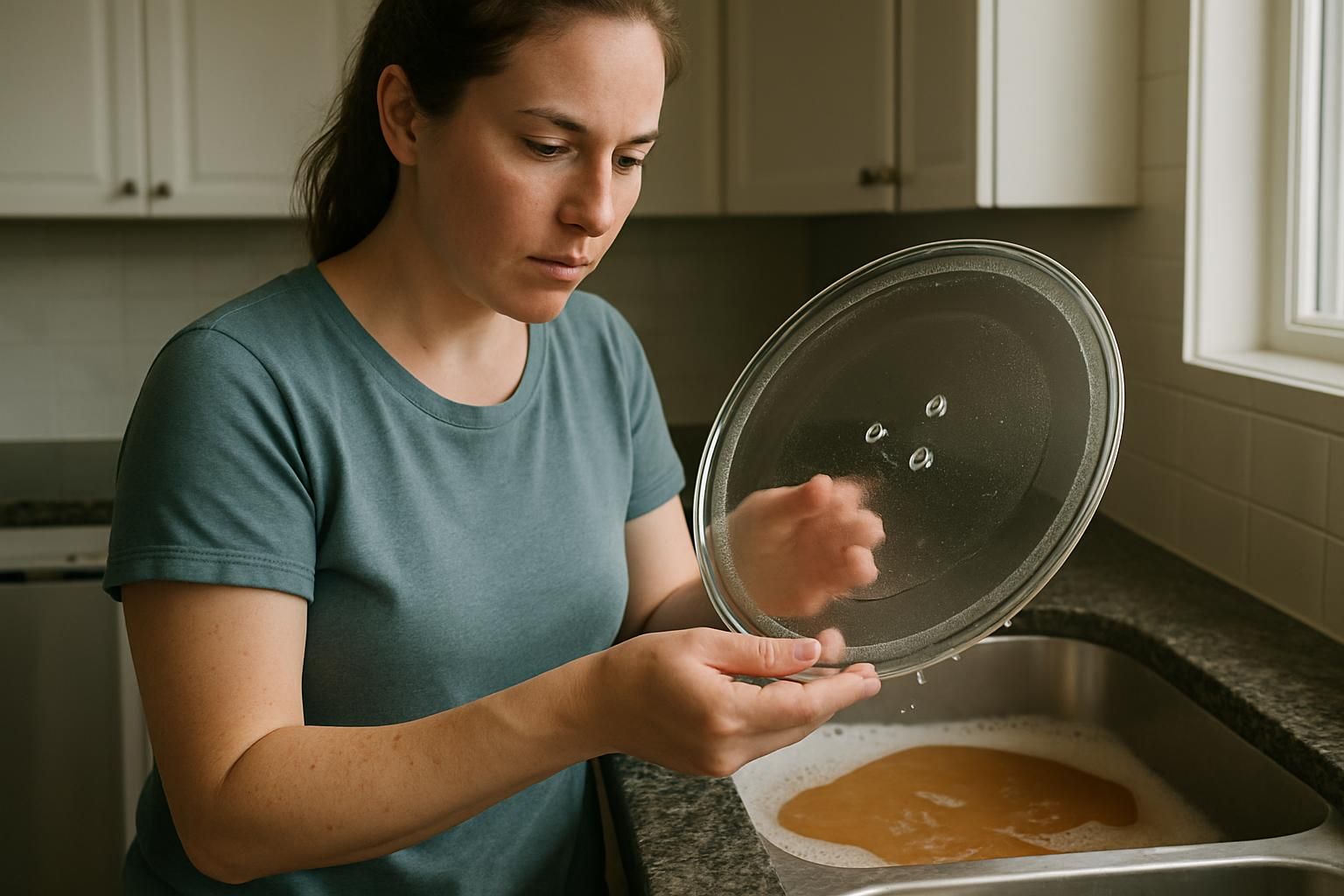
Slide the glass plate out only when it is cool. Hot glass can crack. Check the edges for chips or small cracks that could cut a finger later.
Set the turntable in a sink with warm, soapy water and scrub with a dish cloth or non-abrasive pad. Many plates are dishwasher-safe, but the owner’s manual is the best guide.
Dry the plate and the small roller ring completely. Water spots look bad and can cause squeaks. Before putting parts back, sweep out crumbs that collect under the plate.
Wipe away loose debris
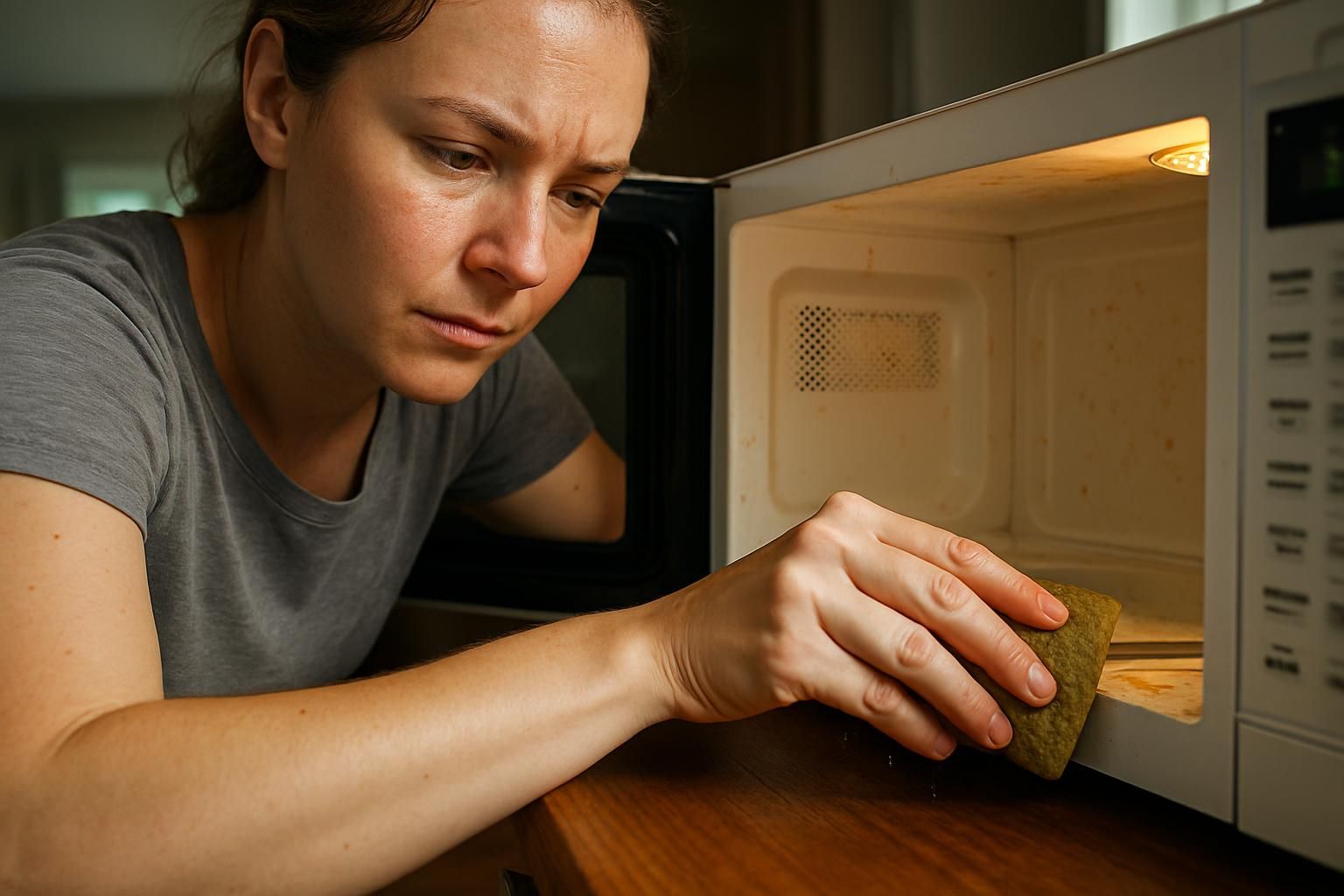
After removing the plate, crumbs often hide in corners or along the walls. Use a damp sponge to pick up those bits and to clear every visible surface.
Splatters from pasta or sauce harden fast, so knock them out now. Start with the side walls and ceiling, then wipe the floor of the cavity. Check under the front lip by the door where cereal crumbs love to sit.
For the exterior, use a clean damp sponge to clear fingerprints and smears. Avoid soaking the controls with extra water. These quick steps make any deep clean easier later with baking soda or a lemon solution, see this deep clean approach for more.
How to Clean a Microwave Using Natural Methods
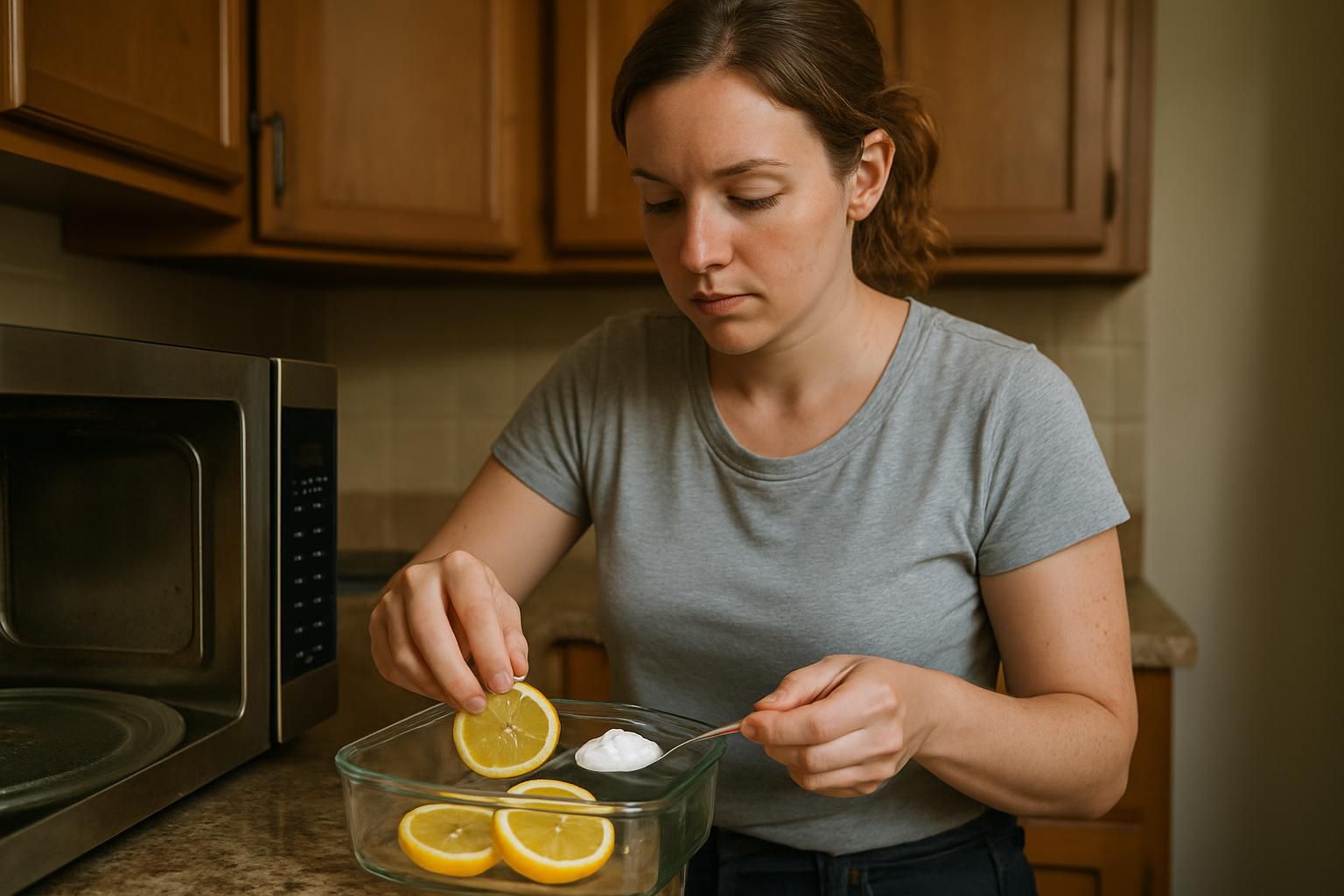
Simple pantry items clean fast and smell fresh. Baking soda, lemon juice, and vinegar create gentle steam cleaning that lifts stuck food in minutes.
Method 1: Lemon and water
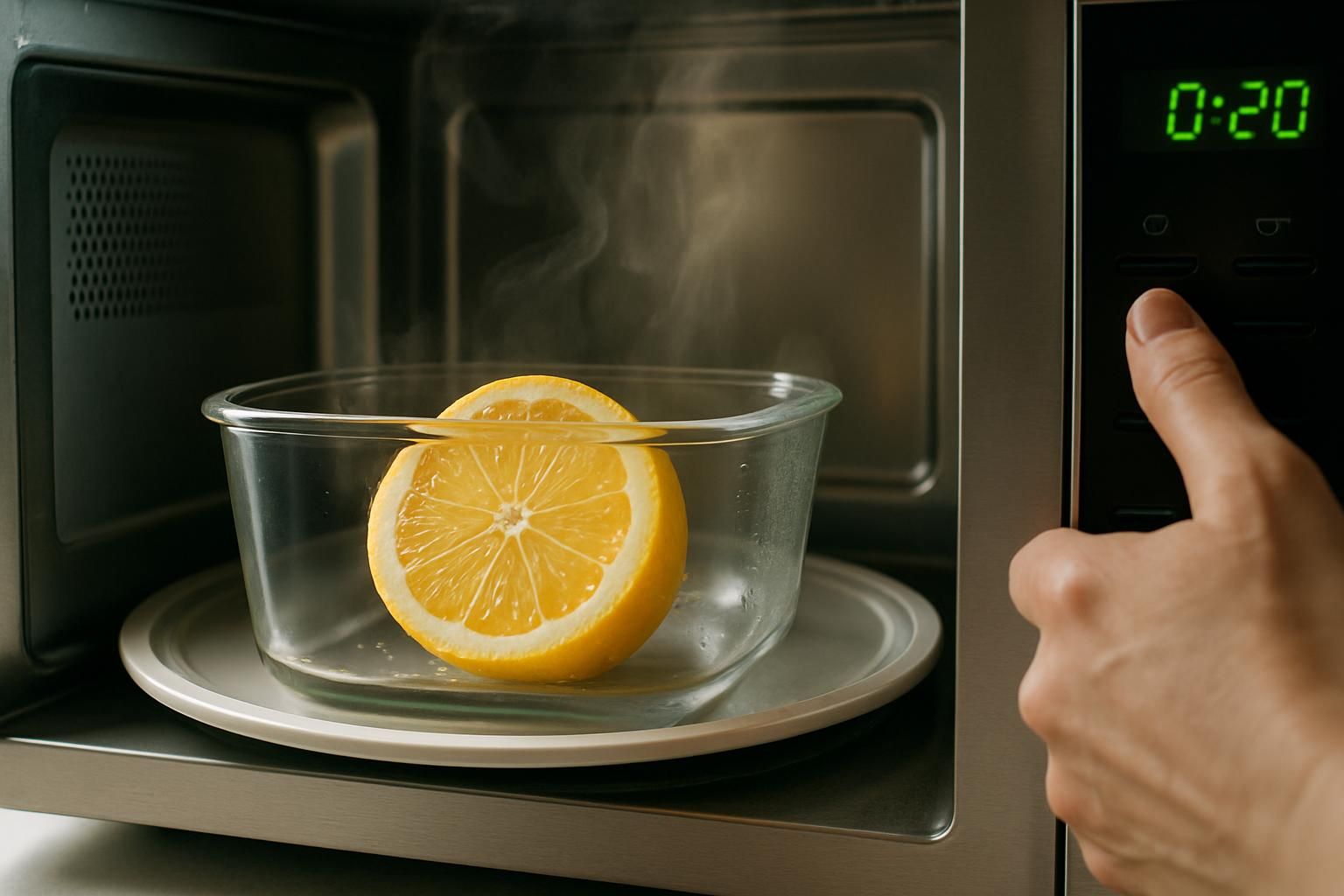
Cut a lemon and squeeze the juice into 1 cup of water in a microwave-safe bowl. Drop in the lemon halves as well. Heat for 2 to 5 minutes until steam fogs the window.
That citrus steam loosens grime on the walls and ceiling. Let it cool for at least a minute so nobody gets burned. Use a cloth or paper towel to wipe away the softened mess.
For strong odors or older stains, add a splash of vinegar to the bowl before heating. After it boils, let the door stay closed for 15 minutes. Lemon leaves a bright scent and shortens scrubbing time for busy families.
Method 2: Vinegar and water
Vinegar packs extra punch on grease. Mix 1 tablespoon of white vinegar with 1 cup of water in a microwave-safe bowl. Heat for three to four minutes until it boils and fills the interior with steam.
Old stains may need a second round. Add a few lemon slices to the vinegar water and heat until boiling, usually about two minutes. Let it sit for 10 to 15 minutes, then wipe clean.
Let the steam cool before opening the door to avoid burns. Vinegar breaks down buildup without harsh chemicals, a win for homes with kids and pets.
Method 3: Baking soda and water
Baking soda is a gentle deodorizer, which means it cancels bad smells at the source. Mix 1 cup of water with 1 to 2 tablespoons of baking soda in a microwave-safe bowl. Heat for about five minutes on high power.
Allow it to cool, then open the door. Wipe every surface with a cloth or sponge. Stains release easily, and leftover odors fade fast.
For history fans, baking soda has been in American kitchens for generations, thanks to brands like Arm & Hammer.
Step-by-Step Process to Deep Clean a Microwave
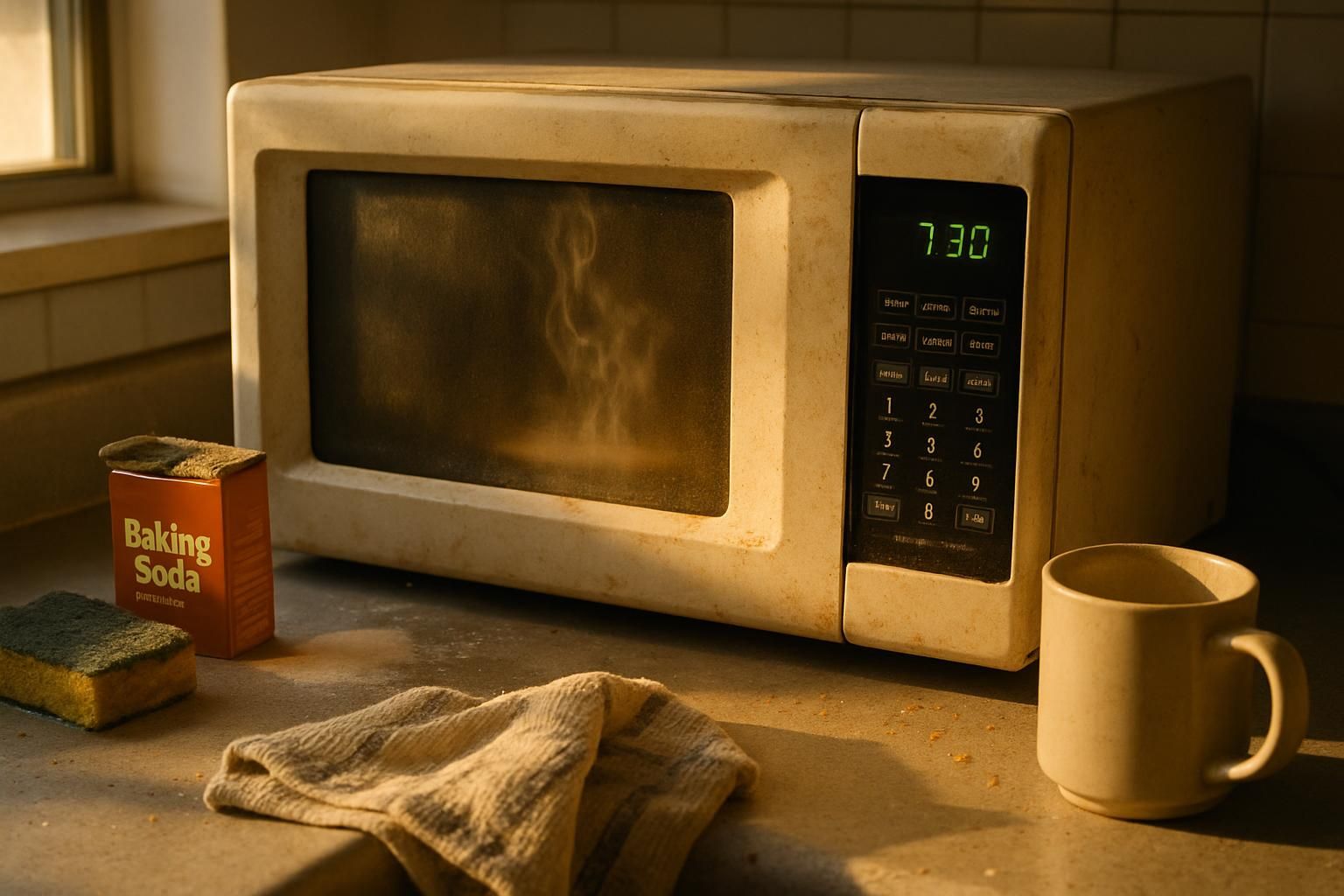
Deep cleaning does not need to be a grind. With steam, a little scrubbing, and common supplies, even tough spots give up fast.
Step 1: Steam the interior
Place a microwave-safe bowl in the center with 1 cup of water and either 1 tablespoon of vinegar or 1 teaspoon of Dawn Platinum dish soap. Heat on high. For a 1200 watt unit, one minute often works. For a 700 watt unit, try two minutes.
After it heats, keep the door closed for three minutes so steam can soften dried food. Put on oven mitts before removing the hot bowl. Steam loosens stains and helps remove odors quickly.
Step 2: Scrub stubborn stains
Use a soft cloth dipped in soapy water to wipe the interior. For crusty bits, switch to a small scrub brush with light pressure. On stainless steel, scrub with the grain to reduce scratches.
If stains hang on, repeat the steam step with lemon or vinegar. Rinse with a clean damp cloth, then dry with a lint-free towel. This prevents streaks and leaves the cavity spotless.
Step 3: Wash the turntable
Let the plate cool. Carry it to the sink and inspect it again. Wash with hot water, dish soap, and a stiff brush.
For sticky spots, let it soak for five minutes. If the manual says dishwasher-safe, set it on the top rack of the dishwasher. Dry fully before putting it back so moisture does not trap under food later.
Step 4: Wipe down the microwave exterior
Clean the outside with soapy water and a soft cloth. For stainless fronts, many parents like Affresh Stainless Steel Cleaning Spray. If using glass cleaner on touch panels, turn on the control lock first.
Wipe panels and handles in small circles. Clean around vents and seams where gunk hides. Dry with a second cloth to stop streaks.
Troubleshooting and Safety Tips: For tough buildup that does not respond immediately, repeat the steam cleaning using lemon juice, vinegar, or baking soda. Use a kitchen glove or paper towel when handling hot items and ensure the microwave is unplugged for extra safety. These tips help clear stubborn residue while keeping safety in mind.
Tips for Cleaning Specific Areas of Your Microwave
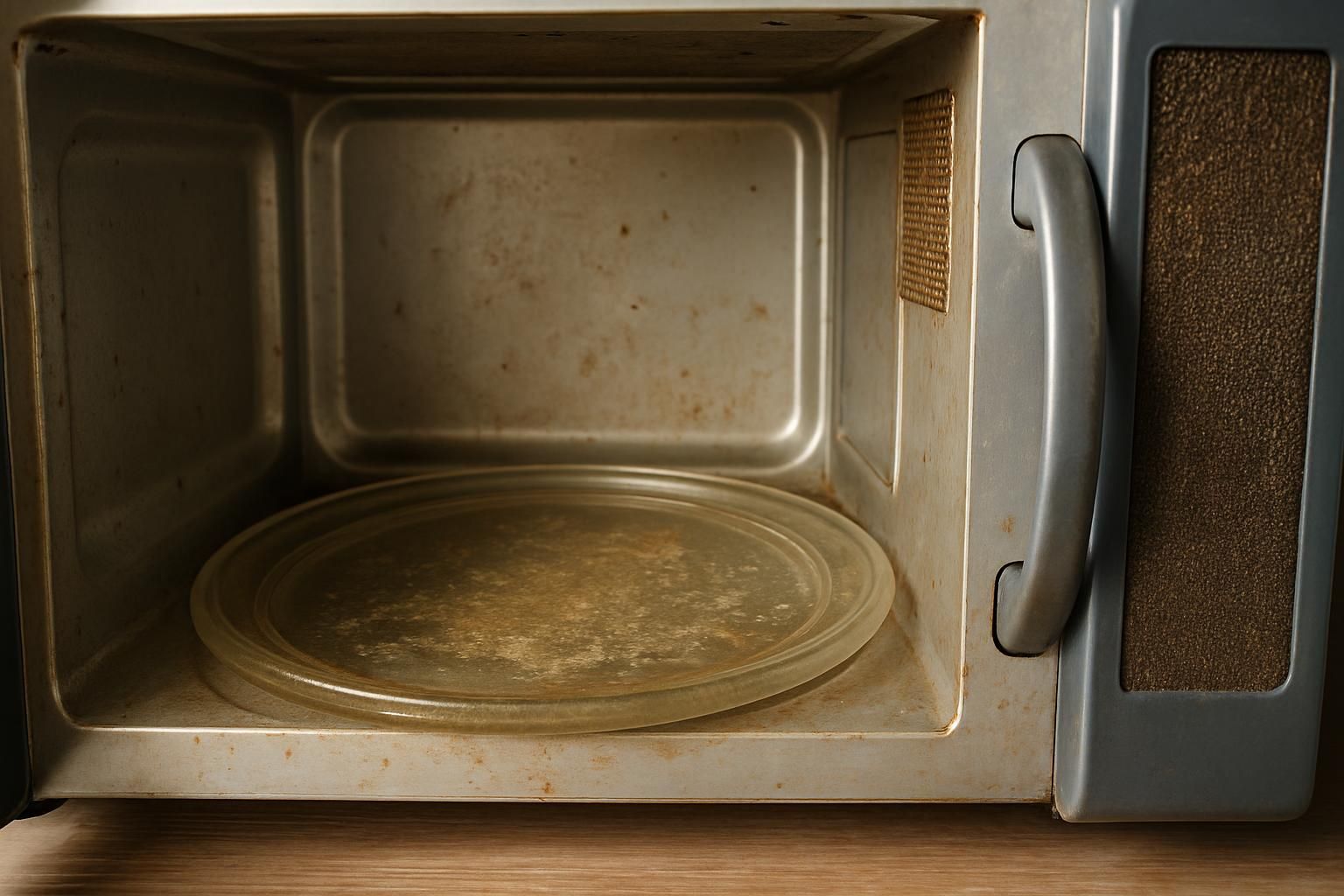
Some parts need special care. A few focused minutes on these spots keeps the appliance fresh longer.
Cleaning the microwave door and seals
Use a damp sponge to wipe the door, window, and the rubber seal. Grease collects around the edges where hands push the door. Dry with a clean towel so no streaks remain.
Skip abrasive pads. They scratch the plastic window and wear down the soft gasket. Regular cleaning of the seal keeps smells from settling in and helps the door close tightly for better heating.
Cleaning the grease filter (if applicable)
Many over-the-range units use reusable grease filters. Remove the filter following the brand’s instructions. Whirlpool and GE, for example, may use different clips.
Soak the filter in warm, soapy water for at least 10 minutes. Scrub gently with a soft brush to remove trapped grease. Rinse well and let it air dry before reinstalling.
If the mesh is worn or still greasy after washing, replace it. A clean filter improves airflow and reduces leftover cooking odors.
How Often Should You Clean Your Microwave?
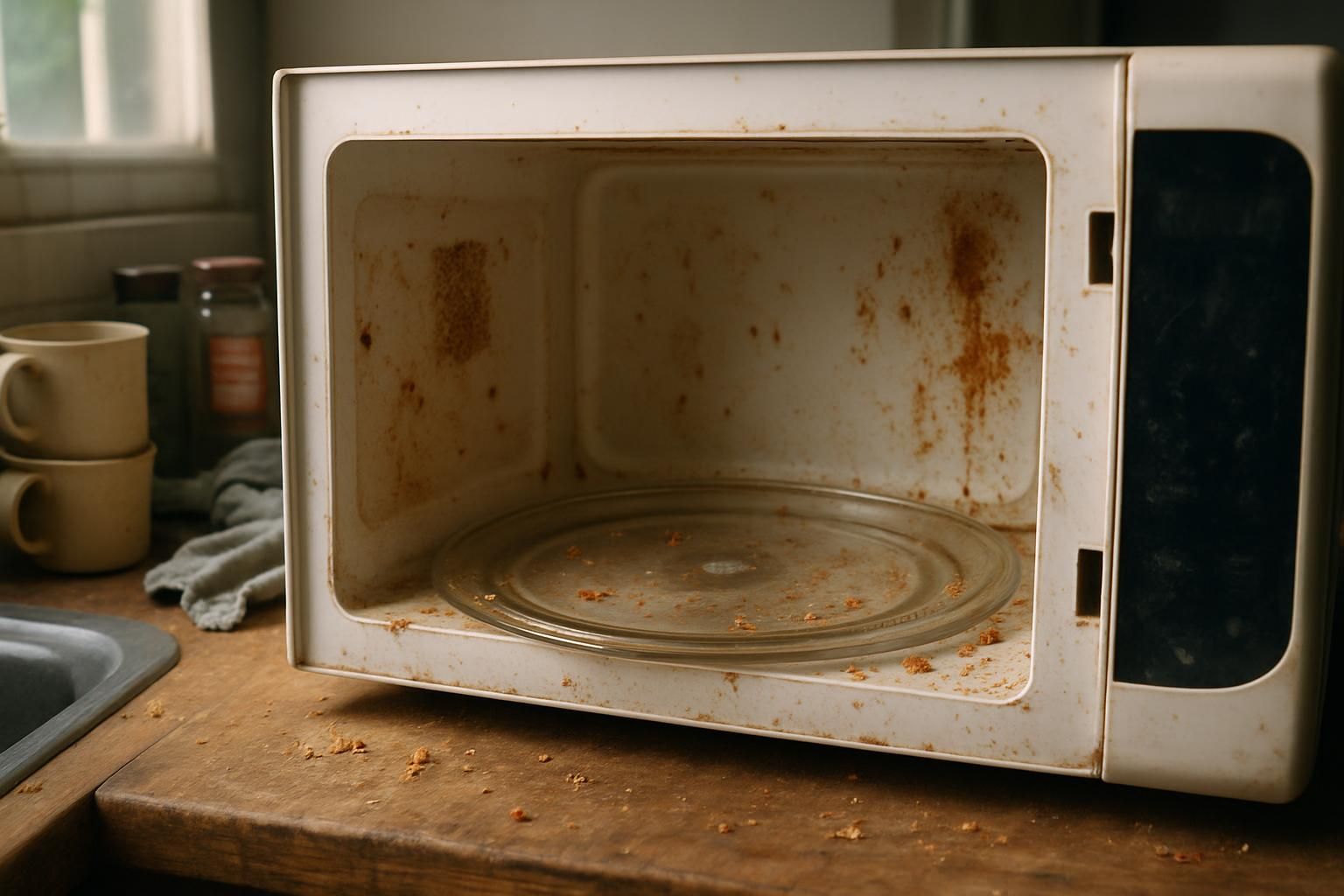
Homes that use the microwave daily should clean it once a week. That habit stops crusty bits from turning into a long scrubbing session later.
Wipe fresh spills right away. Frequent reheating can cause odors to build, so quick wipe-downs keep the air fresh and the seals working well. A little weekly effort can save time in the long run and makes every meal taste like it should.
Preventative Tips to Keep Your Microwave Clean Longer
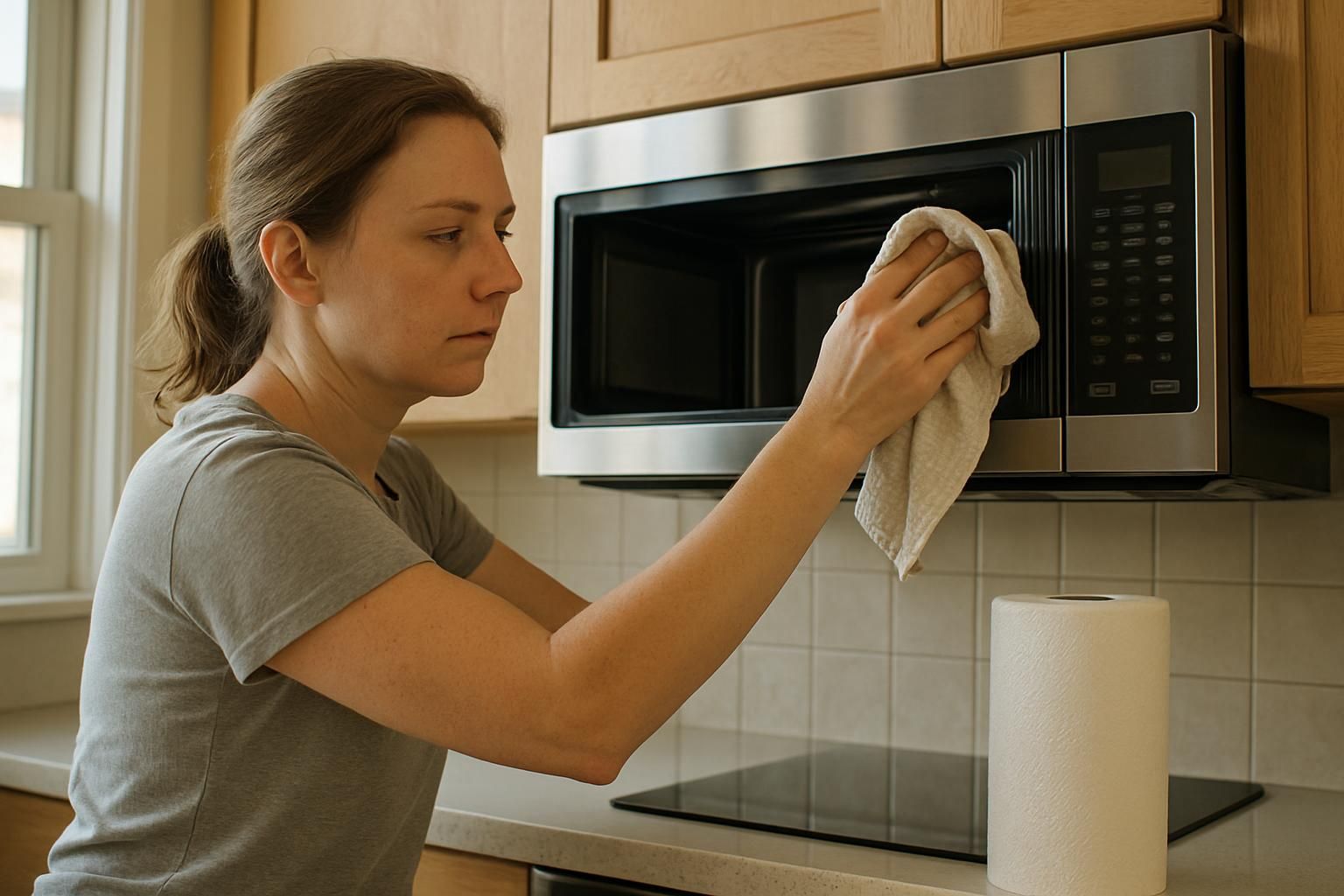
Microwaves at home can go from fine to messy in a day. These habits keep things tidy with almost no effort.
- Cover dishes with a paper towel or a vented microwave-safe cover to catch splatters.
- Lower the power for foods that bubble and pop to reduce blowups.
- Pierce potatoes, sausages, or other steam-heavy foods before cooking to prevent bursts.
- Wipe the interior with a damp cloth after each use so crumbs do not dry and harden.
- Dry the inside and outside with a fresh towel after cleaning to prevent streaks.
- Wash the turntable often with warm soapy water to keep old sauce from setting.
- Clean fingerprints on handles and buttons quickly so grease does not build up.
- Tackle stubborn messes as soon as they appear, waiting makes them tougher later.
- Run lemon slices in water weekly for fresh scent and easy upkeep.
- Teach kids to cover plates, poke hot dogs, and wipe small spills for extra help.
- Keep an absorbent cloth near the microwave so anyone can wipe fast without hunting for supplies.
Conclusion

A sparkling microwave is easy with a few basics. Vinegar, lemon juice, and baking soda handle most stains, and a small amount of dish soap lifts old splatters in minutes. Let steam do the heavy lifting, then wipe with a damp cloth.
Anyone who wants to know how to clean a microwave fast can follow these steps once a week. The kitchen stays fresh, the microwave oven runs better, and meals taste like they should. Small habits now save time tomorrow.
FAQs
1. What is the fastest way to clean a microwave?
Fill a bowl with water and lemon slices, then heat it until steam forms. The steam loosens grime so you can wipe away messes in seconds.
2. Can I use vinegar to remove tough stains inside my microwave?
Yes, mix equal parts vinegar and water in a cup. Heat it for several minutes; the vapor softens stuck-on food, making scrubbing easy as pie.
3. How do I get rid of lingering odors after cleaning my microwave?
Place baking soda on a plate inside your appliance overnight. It absorbs smells like a sponge soaking up spilled milk.
4. Is it safe to use dish soap when cleaning the interior of my microwave?
Absolutely; just dampen a cloth with soapy water and scrub gently. Rinse with another wet rag before drying everything off, or your next meal might taste like suds instead of supper!




